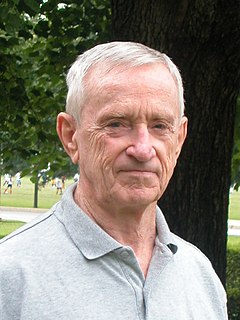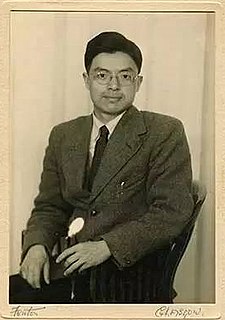
Ketamine is a medication mainly used for starting and maintaining anesthesia. It induces a trance-like state while providing pain relief, sedation, and memory loss. Other uses include for chronic pain, sedation in intensive care, and depression. Heart function, breathing, and airway reflexes generally remain functional. Effects typically begin within five minutes when given by injection and last up to about 25 minutes.

Charles Richard Drew was an American surgeon and medical researcher. He researched in the field of blood transfusions, developing improved techniques for blood storage, and applied his expert knowledge to developing large-scale blood banks early in World War II. This allowed medics to save thousands of lives of the Allied forces. As the most prominent African American in the field, Drew protested against the practice of racial segregation in the donation of blood, as it lacked scientific foundation, and resigned his position with the American Red Cross, which maintained the policy until 1950.
Dissociatives are a class of hallucinogen which distort perceptions of sight and sound and produce feelings of detachment – dissociation – from the environment and self. This is done through reducing or blocking signals to the conscious mind from other parts of the brain. Although many kinds of drugs are capable of such action, dissociatives are unique in that they do so in such a way that they produce hallucinogenic effects, which may include sensory deprivation, dissociation, hallucinations, and dream-like states or trances. Some, which are nonselective in action and affect the dopamine and/or opioid systems, may be capable of inducing euphoria. Many dissociatives have general depressant effects and can produce sedation, respiratory depression, analgesia, anesthesia, and ataxia, as well as cognitive and memory impairment and amnesia.

Michael Ellis DeBakey was a Lebanese-American cardiovascular surgeon, scientist, and medical educator, who became the chancellor emeritus of Baylor College of Medicine in Houston, Texas, director of The Methodist DeBakey Heart & Vascular Center, and senior attending surgeon of The Methodist Hospital in Houston, with a career spanning 75 years.

Robert Lee Park is an American emeritus professor of physics at the University of Maryland, College Park, and a former director of public information at the Washington office of the American Physical Society. Park is most noted for his critical commentaries on alternative medicine and pseudoscience, as well as his criticism of how legitimate science is distorted or ignored by the media, some scientists, and public policy advocates as expressed in his book Voodoo Science. He is also noted for his preference for robotic over manned space exploration.

Daniel Nathans was an American microbiologist. He shared the 1978 Nobel Prize in Physiology or Medicine for the discovery of restriction enzymes and their application in restriction mapping.

Solomon Halbert Snyder is an American neuroscientist who is known for wide-ranging contributions to neuropharmacology and neurochemistry. He studied at Georgetown University, and has conducted the majority of his research at the Johns Hopkins School of Medicine. Many advances in molecular neuroscience have stemmed from Dr. Snyder's identification of receptors for neurotransmitters and drugs, and elucidation of the actions of psychotropic agents, making him one of the most highly cited biologists in the world. He is most famous for his research on the opioid receptor, for which he received the Albert Lasker Award for Basic Medical Research in 1978. He is one of the most highly cited researchers in the biological and biomedical sciences, with the highest h-index in those fields for the years 1983–2002.

Joshua P. Prager M.D., M.S. is a United States physician. Prager specializes in pain medicine and is the director of Center for the Rehabilitation Pain Syndromes (CRPS) at UCLA Medical Plaza.

Esketamine, sold under the brand names Ketanest and Spravato, among others, is a medication used as a general anesthetic and for treatment-resistant depression. Esketamine is used as a nasal spray or by injection into a vein.

Dennis S. Charney is an American biological psychiatrist and researcher, one of the world's leading experts in the neurobiology and treatment of mood and anxiety disorders. He is the author of Neurobiology of Mental Illness, The Physician's Guide to Depression and Bipolar Disorders and Molecular Biology for the Clinician, as well as the author of over 500 original papers and chapters.

Arketamine, also (R)-ketamine or (R)-(−)-ketamine, is the (R)-(−) enantiomer of ketamine. Similarly to racemic ketamine and esketamine, the S(+) enantiomer of ketamine, arketamine is biologically active; however, it is less potent as an NMDA receptor antagonist and anesthetic and thus has never been approved or marketed for clinical use as an enantiopure drug.

Hydroxynorketamine (HNK), or 6-hydroxynorketamine, is a minor metabolite of the anesthetic, dissociative, and antidepressant drug ketamine. It is formed by hydroxylation of the intermediate norketamine, another metabolite of ketamine.

L-4-Chlorokynurenine is an orally active small molecule prodrug of 7-chlorokynurenic acid, a NMDA receptor antagonist. It appears to be a rapid-acting antidepressant.

Matthew Houghton Todd is a British chemist and the Professor and Chair of Drug Discovery of the School of Pharmacy at University College London. He is the founder of Open Source Malaria (OSM) and his research focuses on drug discovery and development for this disease. Recently, he has expanded to other areas, particularly neglected diseases such as tuberculosis and mycetoma in the Open Source Tuberculosis (OSTB) and Open Source Mycetoma (MycetOS) project, through a collaboration with the Drugs for Neglected Diseases Initiative and Erasmus MC. In addition, he has some research activity in catalysis and methodology.
Namandjé Bumpus is an American pharmacologist. She is Associate Dean for Basic Research and Associate Professor of Medicine and Pharmacology and Molecular Sciences at the Johns Hopkins University School of Medicine. Bumpus is known for her research on the metabolism of antiviral drugs used to treat HIV-1 and how genetic variations in drug-processing enzymes may impact these drugs' efficacy. She received a Presidential Early Career Award for Scientists and Engineers in 2016.
Kafui Dzirasa is an American psychiatrist and Associate Professor at Duke University. He looks to understand the relationship between neural circuit malfunction and mental illness. He is a 2019 AAAS Leshner Fellow.

Xu Lizhi, better known as Leetsch Charles Hsu, was a Chinese mathematician and educator. He co-founded the Department of Mathematics of Jilin University and founded the Institute of Applied Mathematics and the Journal of Mathematical Research with Applications at the Dalian University of Technology. Together with American mathematician Henry W. Gould, he established the Gould and Hsu Matrix Inversion Formula in 1973.
Yang Liu is a Chinese-American immunologist. He serves as Director of the Division of Immunotherapy, Institute of Human Virology, University of Maryland Baltimore.
Timothy D. Baker BA, MD, MPH was a professor of international health at the Johns Hopkins Bloomberg School of Public Health. He was also one of the founders of the study of international health.














